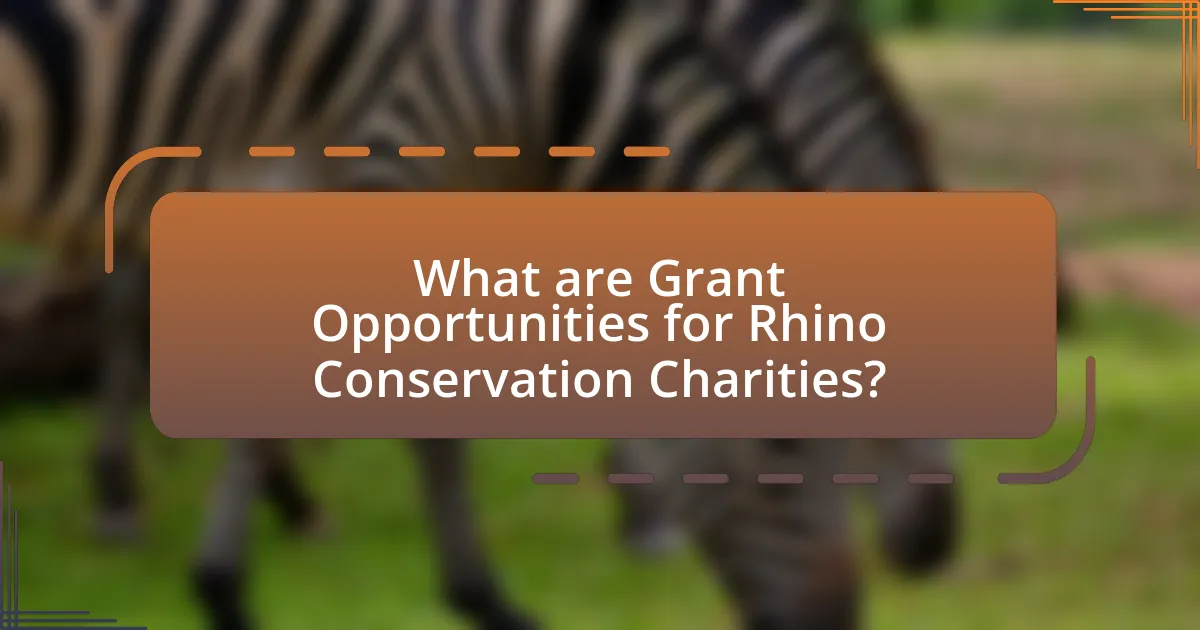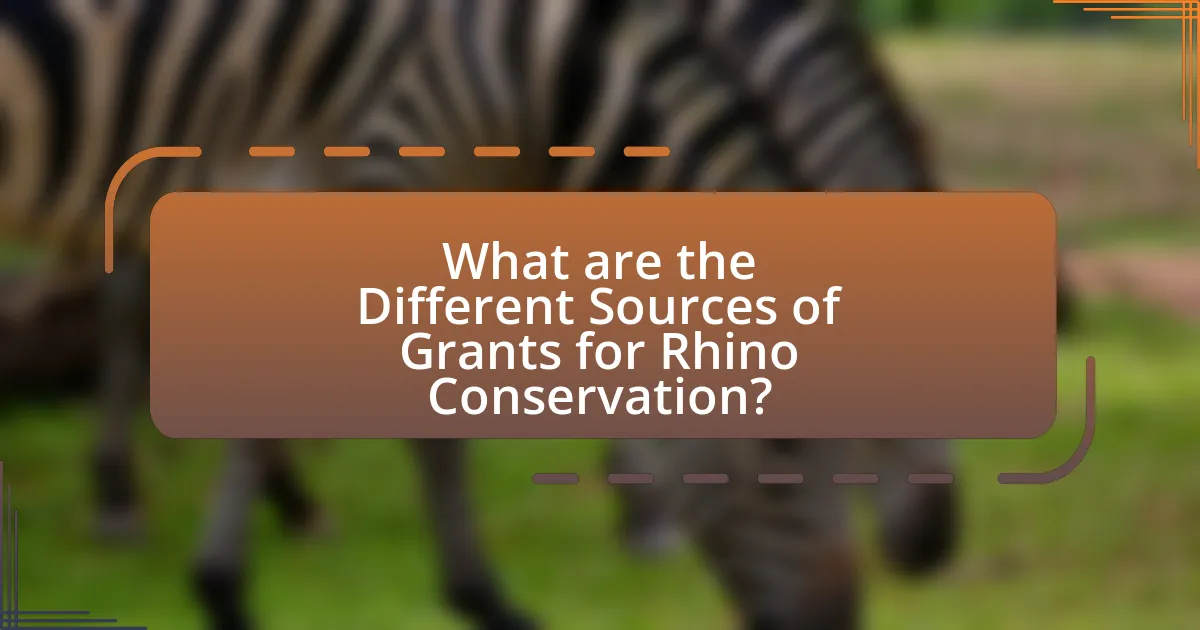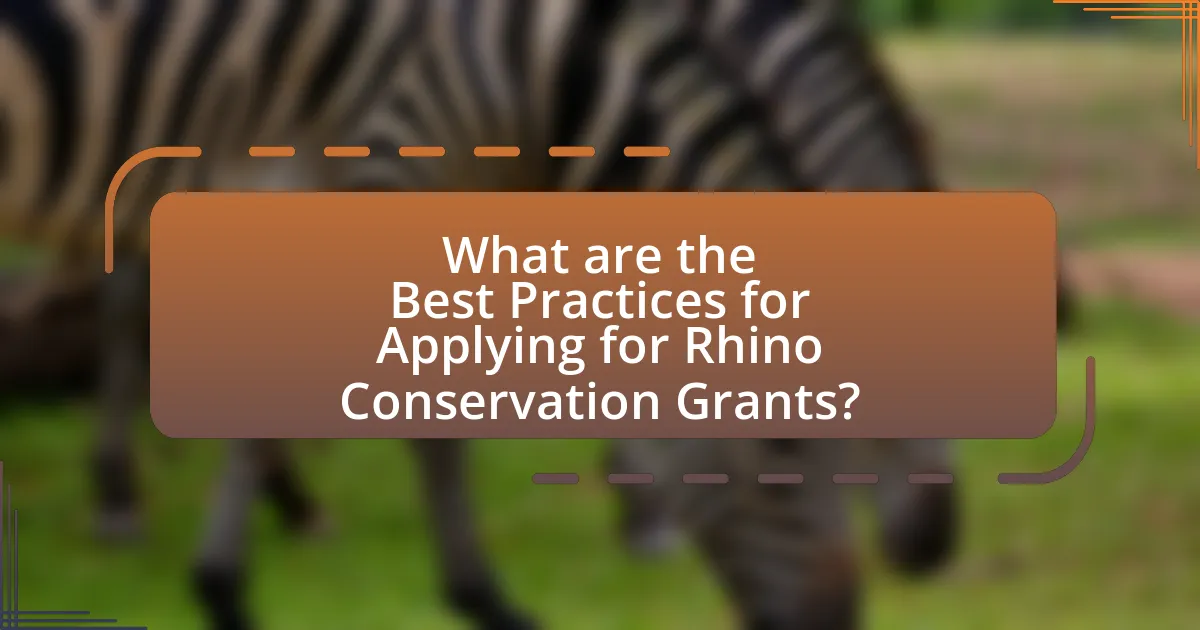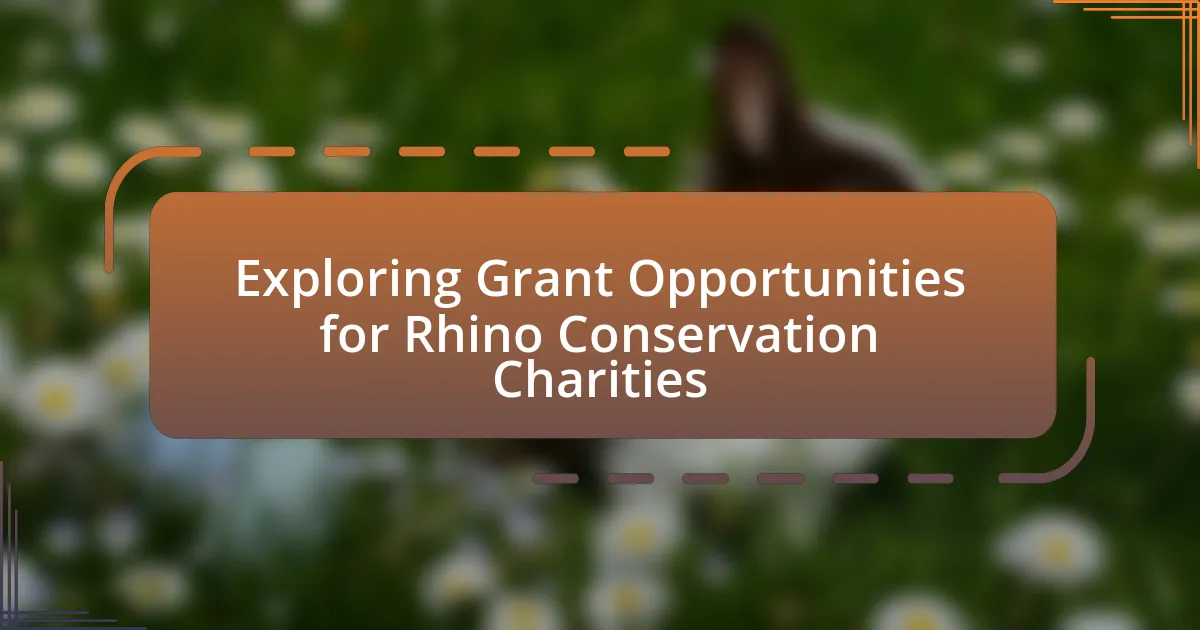The article focuses on grant opportunities available for rhino conservation charities, detailing various funding sources such as governmental agencies, private foundations, and international organizations dedicated to wildlife preservation. It outlines how these grants support critical conservation efforts, including anti-poaching initiatives, habitat preservation, and community engagement programs. The article also discusses the types of projects typically funded, regional variations in grant availability, and best practices for applying for grants. Additionally, it highlights the importance of grants for the sustainability of conservation charities and the challenges they face without adequate funding.

What are Grant Opportunities for Rhino Conservation Charities?
Grant opportunities for rhino conservation charities include funding from governmental agencies, private foundations, and international organizations dedicated to wildlife preservation. Notable sources include the World Wildlife Fund, which offers grants specifically for rhino conservation projects, and the U.S. Fish and Wildlife Service, which provides funding through its African Elephant Conservation Fund. Additionally, the Rhino Recovery Fund supports initiatives aimed at increasing rhino populations and habitat protection. These grants often require detailed project proposals and demonstrate measurable conservation outcomes, ensuring that funds are allocated effectively to combat rhino poaching and habitat loss.
How do these grant opportunities support rhino conservation efforts?
Grant opportunities support rhino conservation efforts by providing essential funding for anti-poaching initiatives, habitat preservation, and community engagement programs. These financial resources enable organizations to implement strategies that directly address the threats rhinos face, such as illegal hunting and habitat loss. For instance, the World Wildlife Fund reported that targeted funding has led to a 50% reduction in poaching rates in certain regions, demonstrating the effectiveness of grants in enhancing conservation outcomes.
What types of projects are typically funded by these grants?
Grants for rhino conservation typically fund projects focused on habitat preservation, anti-poaching initiatives, community engagement, and research on rhino populations. For instance, habitat preservation projects aim to protect and restore ecosystems critical for rhinos, while anti-poaching initiatives often involve training rangers and implementing surveillance technologies. Community engagement projects educate local populations about the importance of rhinos and promote sustainable practices, and research projects gather data on rhino behavior and genetics to inform conservation strategies. These funding priorities align with the overarching goal of ensuring the survival of rhino species in the wild.
How do grant opportunities vary by region or country?
Grant opportunities vary significantly by region or country due to differences in funding availability, governmental policies, and conservation priorities. For instance, countries with established wildlife conservation frameworks, such as South Africa, often have more robust funding mechanisms for rhino conservation, supported by both governmental and non-governmental organizations. In contrast, regions facing political instability or economic challenges may have limited access to grants, impacting the ability of conservation charities to secure necessary funding. Additionally, international organizations may prioritize grants based on regional biodiversity significance, leading to disparities in funding across different areas. For example, the Global Environment Facility allocates resources based on specific environmental needs, which can result in varying levels of support for rhino conservation initiatives in different countries.
Why are grants essential for the sustainability of rhino conservation charities?
Grants are essential for the sustainability of rhino conservation charities because they provide critical funding necessary for ongoing conservation efforts. These charities rely on grants to support various activities, including anti-poaching initiatives, habitat preservation, and community education programs. For instance, the International Rhino Foundation has received grants that enable them to implement effective conservation strategies, which are vital for the survival of rhino populations. Without these financial resources, many conservation projects would face significant cutbacks or complete cessation, jeopardizing the future of rhinos in the wild.
What challenges do rhino conservation charities face without grant funding?
Rhino conservation charities face significant operational challenges without grant funding, primarily due to a lack of financial resources. This financial shortfall limits their ability to implement essential conservation programs, such as anti-poaching initiatives, habitat preservation, and community engagement efforts. For instance, the International Rhino Foundation reports that funding is crucial for employing rangers and conducting surveillance in areas where rhinos are at risk from poaching. Without grants, these charities struggle to maintain staff, secure necessary equipment, and invest in research and development, ultimately jeopardizing their conservation goals.
How do grants enhance the effectiveness of conservation programs?
Grants enhance the effectiveness of conservation programs by providing essential funding that supports various initiatives aimed at preserving biodiversity and ecosystems. This financial support enables organizations to implement research, habitat restoration, and community engagement activities that are crucial for conservation success. For instance, a study published in the journal “Conservation Biology” found that programs funded by grants were able to increase protected areas and improve species recovery rates by up to 30%. Additionally, grants facilitate collaboration among stakeholders, allowing for a more comprehensive approach to conservation challenges, which has been shown to lead to more sustainable outcomes.

What are the Different Sources of Grants for Rhino Conservation?
Different sources of grants for rhino conservation include government agencies, non-governmental organizations (NGOs), private foundations, and international conservation programs. Government agencies, such as the U.S. Fish and Wildlife Service, provide funding through programs aimed at wildlife conservation. NGOs like the World Wildlife Fund and the International Rhino Foundation offer grants specifically for rhino protection initiatives. Private foundations, including the Leonardo DiCaprio Foundation, also contribute financial support for conservation projects. Additionally, international programs such as the Global Environment Facility provide grants that can be allocated to rhino conservation efforts, ensuring a diverse range of funding opportunities for these initiatives.
What types of organizations provide grants for rhino conservation?
Various types of organizations provide grants for rhino conservation, including governmental agencies, non-governmental organizations (NGOs), private foundations, and international conservation bodies. Governmental agencies, such as the U.S. Fish and Wildlife Service, allocate funds specifically for wildlife conservation projects, including rhinos. NGOs like the World Wildlife Fund and Save the Rhino International focus on habitat protection and anti-poaching initiatives, offering grants to support these efforts. Private foundations, such as the Leonardo DiCaprio Foundation, also contribute financial resources to conservation projects. Additionally, international bodies like the Convention on International Trade in Endangered Species of Wild Fauna and Flora (CITES) facilitate funding for rhino conservation through various programs aimed at protecting endangered species.
How do government grants differ from private foundation grants?
Government grants differ from private foundation grants primarily in their funding sources and regulatory requirements. Government grants are funded by federal, state, or local government entities and often come with strict compliance and reporting obligations, reflecting public accountability. In contrast, private foundation grants are funded by private entities or individuals and typically have more flexible guidelines, allowing for a broader range of project types and less stringent reporting requirements. For example, the National Endowment for the Arts, a government agency, mandates specific criteria for funding, while a private foundation like the Ford Foundation may prioritize innovative approaches without such rigid constraints.
What role do international organizations play in funding rhino conservation?
International organizations play a crucial role in funding rhino conservation by providing financial resources, technical expertise, and facilitating partnerships among stakeholders. These organizations, such as the World Wildlife Fund and the International Union for Conservation of Nature, allocate millions of dollars annually to support anti-poaching initiatives, habitat preservation, and community engagement programs. For instance, the World Wildlife Fund reported investing over $1 million in rhino conservation projects in 2020 alone, demonstrating their commitment to preserving these endangered species. Additionally, international organizations often collaborate with local governments and NGOs to enhance the effectiveness of conservation efforts, ensuring that funds are utilized efficiently and sustainably.
How can charities identify potential grant opportunities?
Charities can identify potential grant opportunities by researching funding databases, networking with other organizations, and subscribing to grant alert services. Researching databases such as Grants.gov or Foundation Center provides access to a wide range of available grants tailored to specific causes, including rhino conservation. Networking with other conservation organizations can lead to shared knowledge about funding sources and opportunities. Additionally, subscribing to grant alert services like GrantStation can deliver timely notifications about new grants that align with the charity’s mission. These methods are effective as they leverage existing resources and community connections to uncover funding opportunities.
What resources are available for researching grant opportunities?
Resources available for researching grant opportunities include online databases, government websites, and nonprofit organizations. Online databases such as Grants.gov and the Foundation Center provide comprehensive listings of available grants, including eligibility criteria and application processes. Government websites, like the National Institutes of Health and the National Science Foundation, offer specific funding opportunities related to conservation efforts. Nonprofit organizations, such as the World Wildlife Fund and the International Rhino Foundation, often share grant opportunities relevant to wildlife conservation, including rhino protection initiatives. These resources collectively facilitate access to funding information essential for rhino conservation charities.
How can networking enhance access to grant information?
Networking enhances access to grant information by facilitating connections between individuals and organizations that share similar interests in funding opportunities. Through networking, stakeholders in rhino conservation can exchange insights about available grants, share experiences with the application process, and provide recommendations for successful proposals. For instance, attending conferences or joining professional associations related to wildlife conservation can lead to direct interactions with grantmakers, increasing the likelihood of receiving timely information about new funding sources. Research indicates that 70% of job opportunities and funding leads come from networking, underscoring its effectiveness in accessing critical information.

What are the Best Practices for Applying for Rhino Conservation Grants?
The best practices for applying for rhino conservation grants include thorough research on available funding sources, crafting a clear and compelling project proposal, and demonstrating measurable outcomes. Researching funding sources ensures alignment with grantor priorities, as many organizations focus on specific aspects of conservation, such as habitat protection or anti-poaching efforts. A well-structured proposal should outline the project’s goals, methodologies, and budget, while also highlighting the significance of rhino conservation. Additionally, providing evidence of past successes and partnerships can enhance credibility, as grantors often prefer projects with proven track records. Lastly, including a plan for monitoring and evaluating the project’s impact can further strengthen the application, as it shows a commitment to accountability and effectiveness in conservation efforts.
What key elements should be included in a grant proposal?
A grant proposal should include the following key elements: an executive summary, a statement of need, project goals and objectives, a project description, a budget, and an evaluation plan. The executive summary provides a concise overview of the proposal, while the statement of need outlines the specific problem the project aims to address, such as the decline of rhino populations. Project goals and objectives define what the project intends to achieve, and the project description details the methods and activities planned to reach those goals. The budget outlines the financial requirements, ensuring transparency and accountability, and the evaluation plan describes how the project’s success will be measured. These elements are essential for effectively communicating the project’s purpose and securing funding.
How can charities effectively demonstrate the impact of their work?
Charities can effectively demonstrate the impact of their work by utilizing data-driven metrics and storytelling techniques. For instance, they can collect quantitative data such as the number of rhinos protected, the reduction in poaching incidents, or the increase in community engagement through conservation programs. Additionally, qualitative testimonials from beneficiaries or community members can illustrate the personal impact of their initiatives. Research from the Charities Aid Foundation indicates that organizations that combine statistical evidence with compelling narratives are more successful in conveying their impact to stakeholders and potential funders.
What common mistakes should be avoided in grant applications?
Common mistakes to avoid in grant applications include failing to follow guidelines, submitting incomplete applications, and lacking a clear project narrative. Adhering to specific guidelines is crucial, as many funding organizations automatically disqualify applications that do not meet their requirements. Incomplete applications can lead to misunderstandings about the project’s scope and objectives, which can diminish the chances of funding. Additionally, a clear project narrative is essential; it should articulate the goals, methods, and expected outcomes effectively. Research indicates that applications with well-defined narratives are more likely to receive funding, as they demonstrate a thorough understanding of the project and its impact.
How can charities improve their chances of securing funding?
Charities can improve their chances of securing funding by developing strong, evidence-based proposals that clearly outline their mission, objectives, and the impact of their work. A well-structured proposal that includes specific data on conservation efforts, such as the decline in rhino populations and the effectiveness of previous funding, can demonstrate the urgency and importance of the cause. For instance, according to the International Union for Conservation of Nature, rhino populations have decreased by over 90% in the last century, highlighting the critical need for funding to support conservation initiatives. Additionally, establishing partnerships with other organizations and engaging with the community can enhance credibility and attract more funding opportunities.
What strategies can be employed to build strong relationships with funders?
To build strong relationships with funders, organizations should prioritize transparent communication and demonstrate impact through regular updates and reports. Establishing trust is essential; funders appreciate clarity regarding how their contributions are utilized and the outcomes achieved. For instance, a study by the National Council of Nonprofits indicates that 70% of funders value consistent communication about project progress and challenges. Additionally, engaging funders in the decision-making process and inviting them to site visits or events fosters a sense of partnership and commitment. By actively involving funders, organizations can enhance their relationships and increase the likelihood of continued support.
How important is follow-up communication after submitting a grant application?
Follow-up communication after submitting a grant application is crucial for enhancing the chances of funding approval. Engaging with grantors demonstrates interest, reinforces the applicant’s commitment, and provides an opportunity to clarify any questions or concerns the funder may have. Research indicates that proactive communication can lead to a better understanding of the grantor’s priorities and expectations, which can significantly influence funding decisions. For instance, a study by the National Council of Nonprofits highlights that organizations that maintain open lines of communication with funders often receive more favorable outcomes in their grant applications.
What are some practical tips for successful grant applications in rhino conservation?
Successful grant applications in rhino conservation require a clear, focused proposal that outlines specific conservation goals and measurable outcomes. Applicants should begin by thoroughly researching potential funding sources to ensure alignment with their project objectives, as many grantors prioritize specific conservation strategies or geographic areas.
Additionally, including detailed budgets and timelines enhances credibility, demonstrating that the project is well-planned and feasible. Engaging stakeholders, such as local communities and conservation experts, can provide valuable insights and strengthen the application by showcasing collaborative efforts.
Finally, providing evidence of past successes in similar projects can significantly bolster an application, as it illustrates the applicant’s capability to effectively manage funds and achieve conservation goals.
